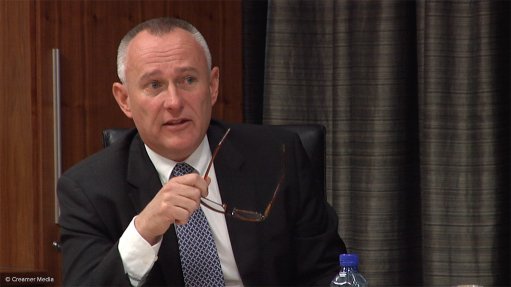
Growthpoint CEO Norbert Sasse
JSE-listed real estate investment trust Growthpoint Properties achieved distribution growth of 8.3% to 161.3c a share during the year ended June 30, outperforming market guidance of 7.2%, the company announced on Wednesday.
Over the year Growthpoint’s net asset value also increased by 14% to R22.15 a share.
Speaking to the media following the release of the full-year results, Growthpoint CEO Norbert Sasse said the period was probably one of the group’s busiest since it had been established, noting that during the financial year Growthpoint had invested about R15-billion in growing its portfolio.
He pointed out that during the year the company had acquired the Abseq and Tiber property portfolios in Gauteng for R1.3-billion and R5.7-billion respectively, while it also acquired interests in Acucap and Sycom for R4.5-billion.
Sasse confirmed that Growthpoint was currently in discussions with Acucap aimed at increasing its current 34.7% stake in the company.
He also pointed out that Acucap and Growthpoint currently collectively held about 95% of Sycom, so, should the negotiations be successful, Growthpoint could in effect in future hold 100% of Acucap and 95% of Sycom.
During the financial year, Growthpoint’s South African property portfolio contributed 75.8% to its R3.5-billion distributable income.
The South African business’ revenue was up 10.4% to R4.8-billion, mainly as a result if the Abseq and Tiber acquisitions, while vacancies shifted 0.5% higher to 4.9% overall.
Sasse explained that this increase was mainly owing to vacancies that formed a part of the properties acquired during the period.
He further pointed out that the local division’s renewal success rate had declined from 66.2% previously to 63%, showing that the current South African market was tough owing to the economy not growing, significant labour unrest and consumers being under pressure.
However, despite this tough and competitive local market, Growthpoint’s business was still in check, Sasse stated.
WATERFRONT
Meanwhile, distributions from Growthpoint’s 50% stake in the V&A Waterfront, in Cape Town, increased by 9.5% on a like-for-like basis and contributed 9.5% to distributable income.
Sasse said the V&A Waterfront seemed to be a bit more resilient to the South African economy than the rest of Growthpoint’s South African businesses.
“This is partly driven by tourism and the weaker rand, as well as the revival of support from locals. [The V&A Waterfront’s] retail sales recorded year-on-year growth of 21.5% and there is keen demand from retailers, and general demand across all uses. It is winning mandates for new corporate head offices and its hotel market is picking up,” he revealed.
AUSTRALIA
Sasse highlighted that Growthpoint had invested an additional R1.9-billion in its Australian business, stating that this business also had a successful year.
Distributions from its strategic holding in Growthpoint Australia grew 13.5% in rand terms on a like-for-like per unit basis, making a noteworthy 14.7% contribution to its total distributable income.
“We continue to see Australia as a market that contains value and we will continue to look for opportunities [to grow],” Sasse said, adding that Growthpoint did not currently play in the Australian retail space, but would consider moving into the retail sector in future.
FUTURE OUTLOOK
With low-growth macroeconomic conditions, rising interest rates and soft demand across all property sectors, Sasse noted that Growthpoint’s operating environment was set to remain challenging in the year ahead.
He said while Growthpoint would perhaps not be able to replicate this year’s growth of above 8% during the 2015 financial year, growth was expected to be between 7% and 7.5%.
“We will continue to identify and pursue revenue-enhancing opportunities to further our objective of delivering sustainable income distributions and capital appreciation for shareholders,” Sasse added.